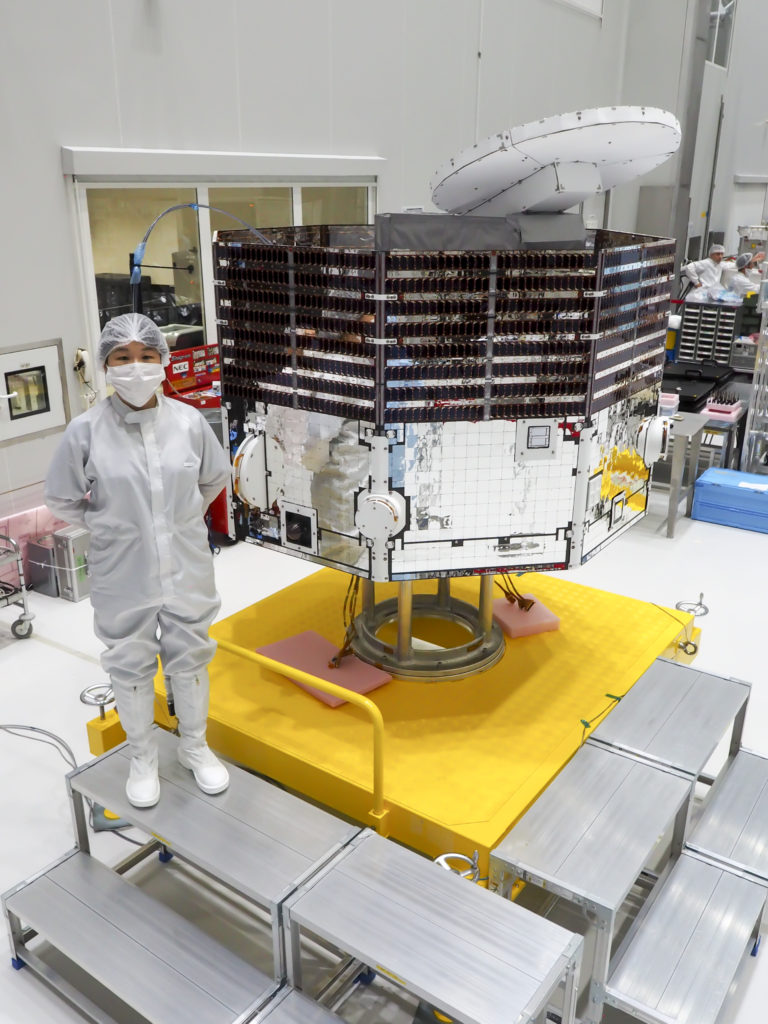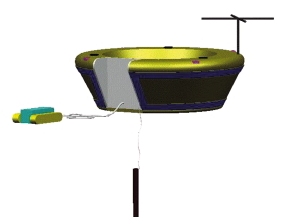Mercury. The planet closest to the Sun. It remains highly mysterious to us. Only two space probes have explored it: Mariner 10, which flew by three times in 1974-75, and then MESSENGER, which orbited the planet’s poles from 2011 to 2015. Both missions were highly innovative and represented pioneers in space exploration. Unfortunately, neither fully succeeded in studying Mercury for several reasons. For Mariner 10, the 3:2 spin-orbit resonance posed a problem. This resonance means that the planet rotates three times on its axis for every two orbits around the Sun. Due to this resonance, Mariner 10 could only illuminate the same areas of Mercury and therefore couldn’t fully map the entire planet. For MESSENGER, this problem didn’t exist because the probe entered a polar orbit around Mercury rather than a heliocentric orbit. However, to avoid overheating, it was decided to place the probe in a highly elliptical orbit. This meant that the heat reflected and emitted by the planet’s surface didn’t attack the probe when it was at its apoapsis. However, this apoapsis was located near Mercury’s South Pole, preventing MESSENGER from properly mapping this part of the planet.

BepiColombo was launched on October 20th at 3:45 CEST to explore this still largely unknown planet. And to accomplish this, the mission carries not one but two probes and no less than sixteen scientific instruments to fully study Mercury: from the planet’s origins to the examination of its thin atmosphere, including measurements of its magnetic field and even an in-depth study of the planet’s orbit to further test Einstein’s General Theory of Relativity. This joint mission between the European Space Agency (ESA) and the Japan Aerospace Exploration Agency (JAXA) is expected to last at least eight years and could be extended by an additional year. However, over this entire duration, we must not forget to consider seven years of travel to reach Mercury, involving no fewer than nine gravitational assists from Earth, Venus, and the planet itself, Mercury.

The Projet’s History
As early as the mid-1980s, the ESA (European Space Agency) began considering sending a probe to Mercury for study. During that same decade, the Mercury Express mission (in reference to Venus Express and Mars Express, two other ESA exploration missions), better known as LUGH (Low-cost Unified Geophysics at Hermes, with Hermes being the Greek god that became Mercury in Roman mythology and thus lent his name to the planet in question), was envisioned. This mission involved launching a mothership that would carry two mini-probes to Mercury. However, LUGH was not selected because its objectives overlapped with those of MESSENGER, the American probe developed simultaneously as part of the Discovery program.

A few years later, in 1996, the scientific committee of the ESA announced the upcoming major missions chosen for its Horizon 2000+ program. These included LISA, for measuring gravitational waves with two satellites, Gaia, a space observatory providing crucial data on the entire sky, and finally, a mission to explore Mercury. The following year, a detailed study of this mission was conducted, leading to the conclusion that two distinct vehicles would be necessary: a three-axis stabilized orbiter for studying the surface, and a spinning orbiter for measuring the magnetic and electric fields. Both vehicles would also need to utilize electric propulsion to reach the planet. This European mission aimed to conduct much more in-depth studies than the American MESSENGER probe and to complement the mapping and topographic surveys conducted by the latter. In September 1999, it was decided to name this mission BepiColombo, in honor of the Italian scientist Giuseppe “Bepi” Colombo, whose calculations enabled NASA engineers to carry out multiple flybys of Mercury with Mariner 10.
![Guiseppe [Bepi] Colombo (ESA)](https://www.kerbalspacechallenge.fr/wp-content/uploads/2024/02/Guiseppe-Colombo-ESA.jpg)
During this same period, on the other side of the Earth, the Japan Institute of Space and Astronautical Science (ISAS), which later became part of JAXA along with two other organizations, was also studying the possibility of sending a probe to Mercury. This probe was planned to be launched by a Japanese H-IIA rocket in 2005, to arrive at its study destination in 2008, where it would be placed in elliptical polar orbit. The goal of this probe was to study the magnetic and electric fields as well as particles from the solar wind. At the beginning of the 21st century, the European and Japanese projects merged, and it was decided that ISAS would develop the spinning orbiter for BepiColombo. The mission was no longer simply international; it became intercontinental!

In the initial plans for BepiColombo, a lander was included. This lander, named the Mercury Surface Element (MSE), was intended to touch down in polar regions near the terminator (the line separating day and night on a celestial body) to minimize thermal constraints. It was designed to weigh 44kg with a diameter of 90cm and a scientific instrument mass of 7kg, including descent and surface cameras, an X-ray spectrometer, a magnetometer, a seismometer, and several other instruments for measuring the thermal and mechanical properties of the soil. Some of these instruments required ground anchoring devices and a means of placing them several meters away from the MSE to avoid data interference, such as in the case of the magnetometer due to the robot’s electrical systems.
Due to the planet’s extremely thin atmosphere, the lander had to rely on retro-rockets, significantly impacting the mass of propellant required. These engines were intended to bring the MSE to a halt at 120m altitude before deploying a series of inflatable cushions to protect it upon impact at a maximum speed of 30m/s. This technique would later be used by NASA to land its Opportunity rover on the surface of Mars.
The MSE lander was supposed to have a 1.7 kWh battery to power it during its seven-day mission. However, the complexity of such a lander, surface thermal constraints, the mass limits of BepiColombo, and budget constraints on ESA following restrictions in 2003 ultimately led to the abandonment of the MSE lander.

Next came the time to choose the launcher for this mission. Two scenarios were considered: the first aimed to send the two probes independently using two Soyuz launchers launching from Baikonur, and the second, technically simpler but more costly, involved sending both probes together aboard an Ariane 5 rocket launched from Kourou. With the development of a new version of the Fregat upper stage of the Soyuz launcher and the construction of a launch pad for it in French Guiana, which would increase its performance through the slingshot effect, it was decided to launch both probes aboard a Soyuz rocket from Kourou in 2013 to arrive in Mercury orbit in 2019.
Initially, BepiColombo was designed to fit within the fairing of the Russian launcher and not to exceed 80% of the maximum payload mass that it could orbit. However, as the project progressed, this mass increased dangerously, and by 2008, the project was on the verge of cancellation. Ultimately, it was decided to launch BepiColombo aboard an Ariane 5, increasing the project’s cost by 120 million euros but allowing for a much heavier payload. In December 2009, the ESA’s Scientific Program Committee approved the reconfiguration, and a contract with Arianespace was signed in September 2011.

In 2007, the ESA selected Astrium Germany (now Airbus Defence and Space) along with Thales Alenia Space Italy for the development of the European probe MPO (Mercury Planetary Orbiter) and the transfer stage MTM (Mercury Transfer Module). Detailed studies showed that the solar panels would not be able to withstand the thermal influx they would experience; their surface area needed to be significantly increased, raising the probe’s mass to 4 tons and confirming the switch from Soyuz to Ariane 5 as the launcher. Despite a cost that reached 970 million euros, the ESA decided to continue with the project. Several delays due to issues mainly during the development of the complex solar-electric propulsion system pushed back the mission’s launch from 2014 to October 2018.

In August 2011, Thales Alenia Space provided a thermal model of the MPO (Mercury Planetary Orbiter) to ESTEC, the European Space Research and Technology Centre. Starting in September of the same year, tests on this model began in the LSS (Large Space Simulator), a large vacuum chamber capable of recreating space conditions, to verify the spacecraft’s resilience to orientation errors in regions close to the Sun. In December 2011, Japan delivered a thermal model of the MMO (Mercury Magnetospheric Orbiter) to ESTEC, which underwent similar tests. Six months later, measurements of the mass distribution of the fully assembled probe commenced. Thales Alenia Space’s Turin factory completed assembly of the BepiColombo model, which was used for final qualifications and the July 2014 flight. The modules were then delivered to ESTEC during the summer of 2015 for final testing to ensure they would not encounter issues once in space. Fortunately, these tests were conducted because a major problem was detected in an electrical regulation unit of the MTM (Mercury Transfer Module). This failure caused a launch delay, pushing the probes to reach Mercury only in December 2025. During the summer of 2017, the final tests were conducted at ESTEC in flight configuration for the journey to Mercury and after separation of the various modules. The four components forming BepiColombo were then delivered to Kourou for assembly and integration with their Ariane 5 launcher.
Ultimately, the total cost of the project for ESA and JAXA amounted to 1.65 billion euros. If you consider these expenses too large and unnecessary, consider that this project could have been funded instantly if every person residing in the European Union and Japan donated 2.60€. By comparison, France spends the equivalent of 861€ per capita on defense annually.

Mission Progression
The BepiColombo mission is one of the most ambitious in history: nearly seven years of travel and no fewer than nine gravitational assists are required to reach the planet with the most challenging orbital conditions, Mercury. Thus, on October 20, 2018, at 3:45 CEST, an Ariane 5 rocket lifts off from the Guiana Space Centre in Kourou. This Ariane 5 carries BepiColombo within its fairing. Two minutes later, the two massive solid rocket boosters (EAP) are expended and jettisoned. At T+3 minutes after launch, the fairing becomes unnecessary and is jettisoned: for the first time, BepiColombo is in direct contact with the vacuum of space. Six minutes after this event, the empty cryogenic main stage (EPC) is separated, and the cryogenic upper stage (ESC-A) takes over propulsion duties. At T+27 minutes, BepiColombo has achieved the intended trajectory: it is on a hyperbolic trajectory to leave Earth with an additional 3km/s velocity compared to Earth’s escape velocity. Less than a quarter of an hour later, the ESA’s antenna at New Norcia in Australia receives the signal from BepiColombo: the launch has proceeded perfectly!

74 minutes after launch, the two massive solar panels of the transfer module (MTM) as well as the European orbiter (MPO) panel are deployed. A photo taken by a camera positioned on the MTM and received 12 hours after liftoff will confirm this deployment. Two other cameras, in the same manner, provide visual evidence of the successful deployment of the MPO’s high-gain antenna and its experiment mast. The antenna was deployed 29 hours and 30 minutes after liftoff, while the mast waited 18 hours to open. Finally, three days after liftoff, the spacecraft subsystems and instruments undergo a final check before starting the long cruise phase. From this point, BepiColombo has already surpassed the lunar orbit for over a day and is approaching leaving the Earth’s sphere of influence: this sphere represents the region where Earth’s gravity dominates over that of any other body.

Two months later, the MEPS propulsion system will be ignited for the first time. The ion thrusters, in operation, will ionize xenon gas for a total of 880 days throughout the mission, divided into more than 25 propulsion phases. Gravitational assists will begin with the first one on April 13, 2020: BepiColombo will pass at approximately 11,200 km from Earth. A few months later, on October 16, 2020, it will be Venus’s turn to receive a visit from the probe, at an altitude of less than 11,000 km. On August 11, 2021, BepiColombo will again pass close to Venus, this time at a distance of only 1,000 km. This will be followed by six Mercury flybys to sufficiently modify BepiColombo’s orbit to minimize fuel costs for orbital insertion. These flybys will occur on October 2, 2021, at 200 km, on June 23, 2022, at 200 km, on June 20, 2023, at 200 km, on September 5, 2024, at 200 km, on December 2, 2024, at 40,000 km, and finally on January 9, 2025, at 345 km.
From this last date, BepiColombo will be on a trajectory almost identical to that of Mercury. It will only require a small impulse from the chemical engines of the MPO to be placed in a polar orbit around the planet. But before this insertion, the transfer module (MTM) will be jettisoned as it becomes unnecessary, beginning in October 2025. On December 5 of the same year, the liquid propulsion engines of the European orbiter MPO will be ignited to place it in a highly elliptical orbit (674 km by 178,000 km). This insertion will be achieved using a method known as “weak stability boundary capture.” This method involves bringing the spacecraft to the edge of the gravitational sphere (at the Lagrange points Mercury-Sun L1 or L2) to be gently captured by the body, in this case, Mercury.

Once this initial orbital insertion is achieved, the MPO will ignite its thrusters five times to lower the altitude of its apoapsis to reach a polar orbit of 590 km by 11,640 km: the orbit of the MMO, the Japanese probe. The MMO will be released shortly afterward, but this separation is subject to certain technical constraints: loss of signal in the event of an Earth-Mercury opposition, inability to perform maneuvers within a zone of approximately 60° of the periapsis to avoid unforeseen overheating, and potential eclipses affecting the power supply of the MMO. Once the MMO is released, the MOSIF protective skirt will also be separated as it becomes unnecessary. The MPO orbiter will then perform a series of ten maneuvers to reach its final orbit: 480 km by 1500 km. In total, the orbital insertion phase will last three months, with an additional month for commissioning of the European probe.

The exploration phase of Mercury is therefore scheduled to begin around early 2026 and is intended to last for one Earth year, during which Mercury will have completed four orbits around the Sun. However, there are plans to extend this phase for an additional year if the equipment continues to function. In total, the journey to Mercury will have lasted over seven years, covering a distance of nine billion kilometers and completing more than 18 solar orbits. BepiColombo will reach a peak speed of 60 km/s, making the 7.7 km/s of the ISS in Earth orbit seem insignificant. Due to the potential 240 million km separating BepiColombo from Earth, a signal could take over 13 minutes to complete a one-way journey between ground antennas and the probes’ antennas.
To learn more
You want to learn more about the technical aspects of the mission as well as all the instruments it carries? Go read this second article, which delves much deeper into the architecture of the various modules.
If you want to see plenty of beautiful images of the mission, whether it’s of the launch, its fabrication, or even later, those taken by the probes, go check out the ESA gallery.



